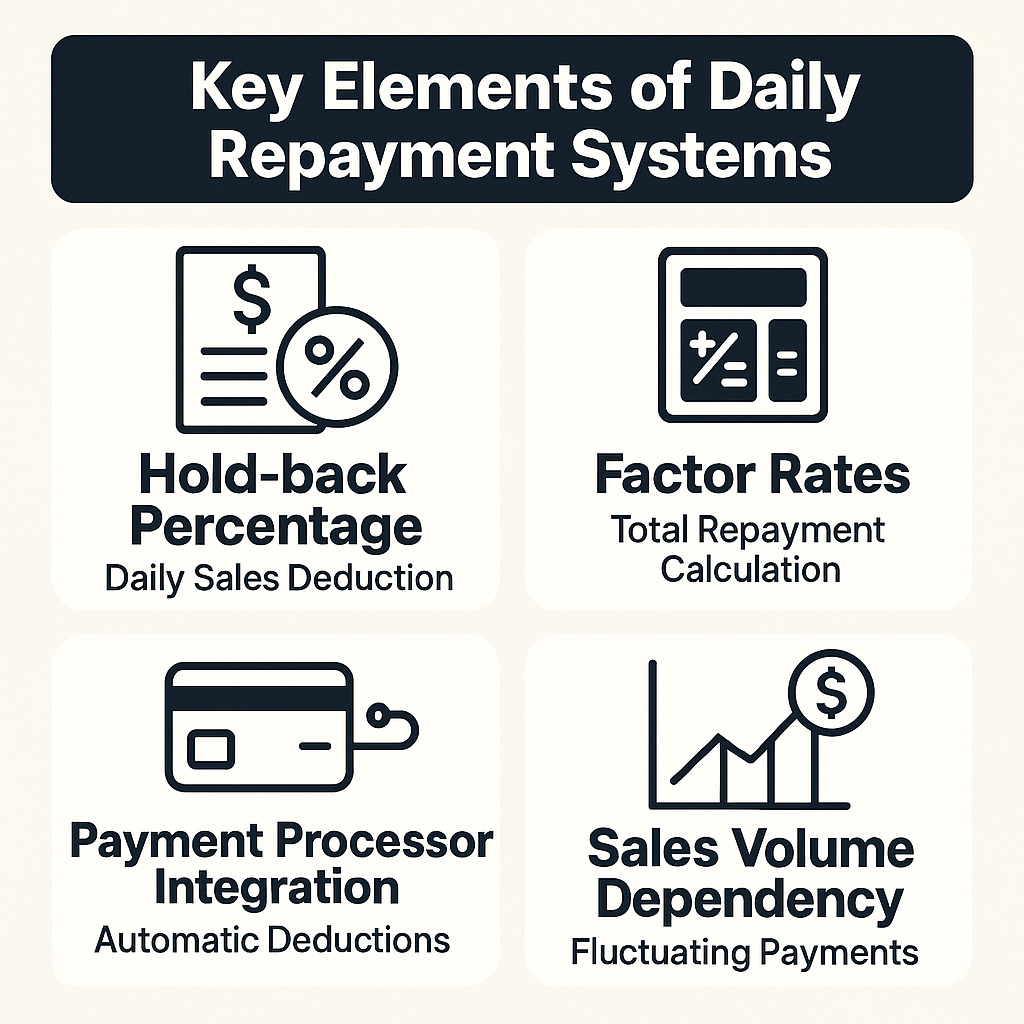How Daily Repayment Structures Work
Understanding how daily repayment structures work might be one of the most important factors when considering merchant cash advance funding for your business. Unlike traditional financing options that typically require monthly payments, merchant cash advances operate through a unique system where repayments are collected directly from your daily sales. This approach can significantly impact your cash flow and requires careful planning to ensure it aligns with your business operations.
The structure involves what's commonly called a hold-back percentage, where a fixed portion of your daily card sales is automatically deducted to repay the advance. This system creates a direct connection between your business performance and repayment schedule, making it essential to grasp how these mechanisms function before moving forward with this type of funding.
Essential Components of Daily Repayment Systems

Daily repayment systems in merchant cash advances include several key components that work together to create the overall structure. These elements determine how much you'll pay each day and how the process integrates with your business operations.
- Hold-back percentage: This fixed percentage of daily card sales gets automatically deducted, typically ranging from 10% to 20% depending on your agreement
- Factor rates: These rates determine the total repayment amount and differ from traditional interest rates in their calculation method
- Payment processor integration: The system connects directly with your merchant account to enable automatic daily deductions
- Sales volume dependency: Your repayment amount fluctuates based on actual daily sales performance rather than fixed monthly amounts
How Sales-Based Deductions Function
Sales-based deductions represent the core mechanism through which daily repayment structures operate. This system automatically calculates and withdraws a predetermined percentage from your daily credit card transactions.
- Automatic calculation: The system processes your daily sales and applies the agreed-upon percentage without manual intervention
- Real-time processing: Deductions typically occur as transactions are processed, ensuring immediate collection
- Variable amounts: Higher sales days result in larger deductions, while slower days produce smaller payments
- Weekend and holiday adjustments: The system may adjust for days when no sales occur or process accumulated amounts on the next business day
Cash Flow Pacing Strategies
Effective cash flow pacing becomes crucial when working with daily repayment structures, as these systems can impact your available working capital throughout each business day.
- Revenue forecasting: Plan for the reduced daily cash availability by projecting sales and calculating expected deductions
- Seasonal adjustments: Account for busy and slow periods in your business cycle when planning cash flow needs
- Emergency reserves: Maintain additional cash reserves to handle unexpected expenses or slower sales periods
- Expense timing: Schedule major purchases and bill payments around your expected cash flow patterns after deductions
Steps to Optimize Merchant Account Automation
Merchant account automation plays a vital role in ensuring smooth daily repayment operations. Following these steps can help you maximize the efficiency of your automated payment systems.
- Verify processor compatibility: Ensure your current payment processor can integrate seamlessly with the daily repayment system before proceeding with the advance
- Set up monitoring tools: Implement systems to track daily deductions and remaining balances to maintain visibility over your repayment progress
- Configure backup payment methods: Establish alternative payment arrangements for days when card sales might be insufficient to cover minimum requirements
- Test the integration: Run trial periods to confirm the automation works correctly and doesn't interfere with your normal business operations
Managing Repayment Caps and Limits
Understanding and implementing appropriate repayment caps can help protect your business from excessive daily deductions that might strain your cash flow operations.
- Negotiate daily maximums: Work with your funding provider to establish reasonable daily deduction limits that won't overwhelm your cash flow needs
- Implement percentage controls: Set controls to prevent deductions from exceeding a certain percentage of daily revenue, leaving adequate funds for operations
- Monitor collection patterns: Track how the daily collections align with your business cycles and request adjustments if needed
- Plan for high-volume days: Understand how busy sales periods will affect your deduction amounts and prepare accordingly
Key Considerations for Business Success
Successfully managing daily repayment structures requires careful consideration of how these systems align with your specific business model and operational needs. The flexible nature of sales-based repayments can offer advantages for businesses with fluctuating revenue patterns, as slower sales periods naturally result in lower deduction amounts. However, this flexibility also means that planning becomes more complex compared to fixed monthly payment schedules.
Modern funding providers are increasingly offering more adaptable repayment models that go beyond the traditional fixed percentage approach. These evolving structures may provide better alignment with your unique cash flow patterns, making it worthwhile to explore various options before committing to a specific arrangement. The key lies in finding a balance between manageable daily deductions and reasonable repayment timelines that support your business growth objectives.
Mastering how daily repayment structures work can help you make informed decisions about merchant cash advance funding that truly supports your business goals. The combination of sales-based deductions, strategic cash flow pacing, and proper merchant account automation creates a system that adapts to your business performance while maintaining consistent progress toward full repayment.
Remember that these structures require active management and careful planning to ensure they complement rather than complicate your business operations. By understanding the mechanics, implementing appropriate safeguards, and working with reputable funding providers, you can leverage daily repayment systems as an effective tool for accessing the capital your business needs to grow and thrive.

.png)






